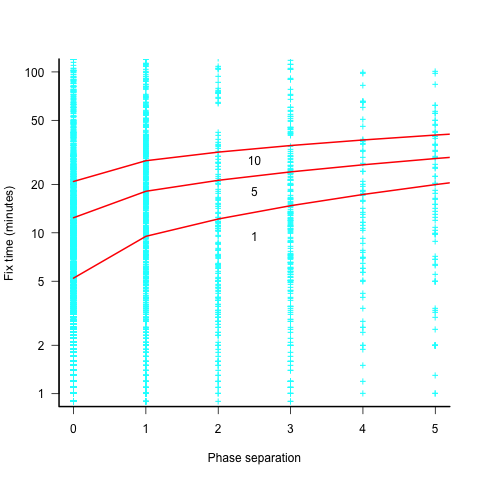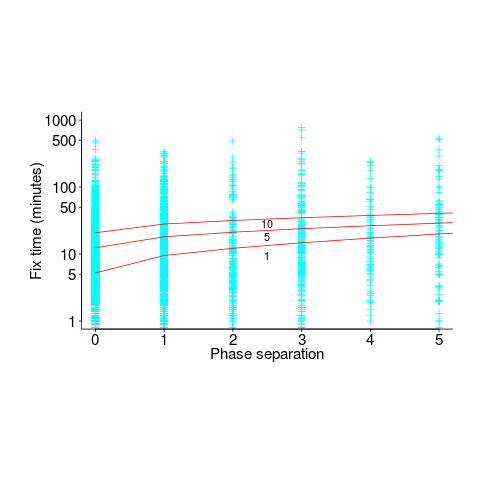Archive
Increase in defect fixing costs with distance from original mistake
During software development, when a mistake has been made it may be corrected soon after it is made, much later during development, by the customer in a shipped product, or never corrected.
If a mistake is corrected, the cost of correction increases as the ‘distance’ between its creation and detection increases. In a phased development model, the distance might be the number of phases between creation and detection; in a throw it at the wall and see if it sticks development model, the distance might be the number of dependencies on the ‘mistake’ code.
There are people who claim that detecting mistakes earlier will save money. This claim overlooks the cost of detecting mistakes, and in some cases earlier detection is likely to be more expensive (or the distribution of people across phases may rate limit what can be done in any phase). For instance, people might not be willing to read requirements documents, but be willing to try running software; some coding mistakes are only going to be encountered later during integration test, etc.
Folklore claims of orders of magnitude increases in fixing cost, as ‘distance’ increases, have been shown to be hand waving.
I know of two datasets on ‘distance’ between mistake creation and detection. A tiny dataset in Implementation of Fault Slip Through in Design Phase of the Project (containing only counts information; also see figure 6.41), and the CESAW dataset.
The plot below shows the time taken to fix 7,000 reported defects by distance between phases, for CESAW project 615 (code+data). The red lines are fitted regression models of the form  , for minimum fix times of 1, 5 and 10 minutes:
, for minimum fix times of 1, 5 and 10 minutes:

The above plot makes various simplifying assumptions, including: ‘sub-phases’ being associated with a ‘parent’ phase selected by your author, and the distance between all pairs of adjacent phase is the same (in terms of their impact on fix time).
A more sophisticated data model might change the functional form of the fitted regression model, but is unlikely to remove the general upward trend.
There are lots of fix times taking less than five minutes. Project 615 developed safety critical software, and so every detected mistake was recorded; on other projects, small mistakes would probably been fixed without an associated formal record.
I think that, if it were not for the, now discredited, folklore claiming outsized relative costs for fixing reported defects at greater ‘distances’ from the introduction of a mistake, this issue would be a niche topic.
Time-to-fix when mistake discovered in a later project phase
Traditionally the management of software development projects divides them into phases, e.g., requirements, design, coding and testing. A mistake introduced in one phase may not be detected until a later phase. There is long-standing folklore that earlier mistakes detected in later phases are much much more costly to fix persists, despite the original source of this folklore being resoundingly debunked. Fixing a mistake later is likely to a bit more costly, but how much more costly? A lack of data prevents reliable analysis; this question also suffers from different projects having different cost-to-fix profiles.
This post addresses the time-to-fix question (cost involves all the resources needed to perform the fix). Does it take longer to correct mistakes when they are detected in phases that come after the one in which they were made?
The data comes from the paper: Composing Effective Software Security Assurance Workflows. The 35,367 (yes, thirty-five thousand) logged fixes, from 39 projects drawn from three organizations, contains information on: phases in which the mistake was made and fixed, time taken, person ID, project ID, date/time, plus other stuff 🙂
Every project has its own characteristics that affect time-to-fix. Project 615, avionics software developed by organization A, has the most fixes (7,503) and is analysed here.
Avionics software is safety critical, and each major phase included its own review and inspection. The major phases include: requirements gathering, requirements analysis, high level design, design, coding, and testing. When counting the number of phases between introduction/fix, should review and inspection each count as a phase?
The primary reason for doing a review and inspection is to check the correctness (i.e., lack of mistakes) in the corresponding phase. If there is a time-to-fix penalty for mistakes found in these symbiotic-phases, I suspect it will be different from the time-to-fix penalty between major phases (which for simplicity, I’m assuming is major-phase independent).
The time-to-fix has a resolution of 1-minute, and some fix times are listed as taking a minute; 72% of fixes are recorded as taking less than 10-minutes. What kind of mistakes require less than 10-minutes to fix? Typos and other minutiae.
The plot below shows time-to-fix for mistakes having a given ‘distance’ between introduction/fix phase, for fixes taking at least 1, 5 and 10-minutes (code+data):

There is a huge variation in time-to-fix, and the regression lines (which have the form:  ) explains just 6% of the variance in the data, i.e., there is a small increase with phase separation, but it is almost down in the noise.
) explains just 6% of the variance in the data, i.e., there is a small increase with phase separation, but it is almost down in the noise.
All but one of the 38 people who worked on the project made multiple fixes (30 made more than 20 fixes), and may have got faster with practice. Adding the number of previous fixes by people making more than 20 fixes to the model gives:  , and improves the model by less than 1-percent.
, and improves the model by less than 1-percent.
Fixing mistakes is a human activity, and individual performance often has a big impact on fitted models. Adding person ID to the model as a multiplication factor: i.e.,  , improves the variance explained to 14% (better than a poke in the eye, just). The fitted value of
, improves the variance explained to 14% (better than a poke in the eye, just). The fitted value of  varies between 0.66 and 1.4 (factor of two, human variation).
varies between 0.66 and 1.4 (factor of two, human variation).
The answer to the time-to-fix question posed earlier (for project 615), is that it does take slightly longer to fix a mistake detected in phases occurring after the one in which the mistake was introduced. The phase difference is tiny, with differences in human performance having a bigger impact.
Recent Comments